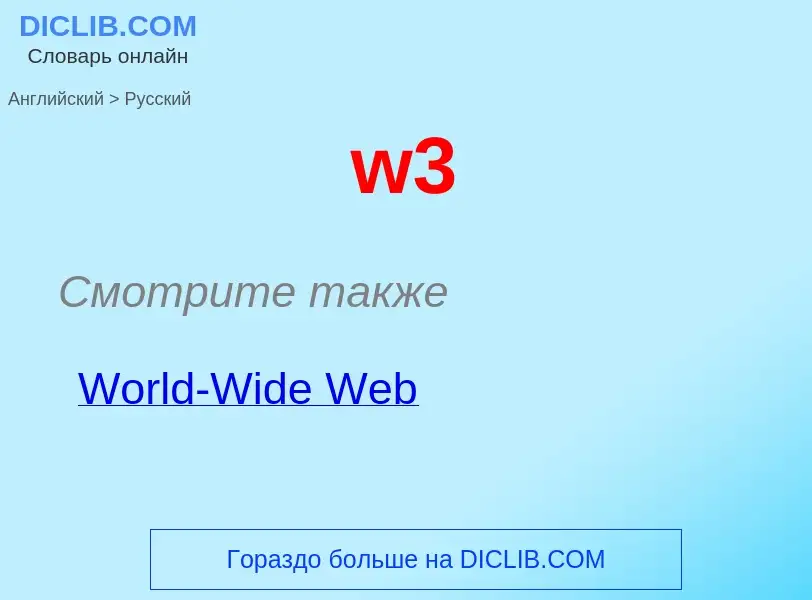Перевод и анализ слов искусственным интеллектом ChatGPT
На этой странице Вы можете получить подробный анализ слова или словосочетания, произведенный с помощью лучшей на сегодняшний день технологии искусственного интеллекта:
- как употребляется слово
- частота употребления
- используется оно чаще в устной или письменной речи
- варианты перевода слова
- примеры употребления (несколько фраз с переводом)
- этимология
W3 - перевод на русский
Смотрите также
Определение
Википедия
The World Wide Web (WWW), commonly known as the Web, is an information system enabling documents and other web resources to be accessed over the Internet.
Documents and downloadable media are made available to the network through web servers and can be accessed by programs such as web browsers. Servers and resources on the World Wide Web are identified and located through character strings called uniform resource locators (URLs). The original and still very common document type is a web page formatted in Hypertext Markup Language (HTML). This markup language supports plain text, images, embedded video and audio contents, and scripts (short programs) that implement complex user interaction. The HTML language also supports hyperlinks (embedded URLs) which provide immediate access to other web resources. Web navigation, or web surfing, is the common practice of following such hyperlinks across multiple websites. Web applications are web pages that function as application software. The information in the Web is transferred across the Internet using the Hypertext Transfer Protocol (HTTP).
Multiple web resources with a common theme and usually a common domain name make up a website. A single web server may provide multiple websites, while some websites, especially the most popular ones, may be provided by multiple servers. Website content is provided by a myriad of companies, organizations, government agencies, and individual users; and comprises an enormous amount of educational, entertainment, commercial, and government information.
The World Wide Web has become the world's dominant software platform. It is the primary tool billions of people worldwide use to interact with the Internet.
The Web was invented by Tim Berners-Lee at CERN in 1989 and opened to the public in 1991. It was conceived as a "universal linked information system".


![The inside and front of a [[Dell PowerEdge]] web server, a computer designed for [[rack mount]]ing The inside and front of a [[Dell PowerEdge]] web server, a computer designed for [[rack mount]]ing](https://commons.wikimedia.org/wiki/Special:FilePath/Inside and Rear of Webserver.jpg?width=200)
![Mosaic]] web browser helped to make the web much more usable, to include the display of images and moving images ([[GIF]]s). Mosaic]] web browser helped to make the web much more usable, to include the display of images and moving images ([[GIF]]s).](https://commons.wikimedia.org/wiki/Special:FilePath/Internet Key Layers.png?width=200)
![The results of a search for the term "lunar eclipse" in a web-based [[image search]] engine The results of a search for the term "lunar eclipse" in a web-based [[image search]] engine](https://commons.wikimedia.org/wiki/Special:FilePath/Mayflower Wikimedia Commons image search engine screenshot.png?width=200)
![usap.gov]] website usap.gov]] website](https://commons.wikimedia.org/wiki/Special:FilePath/United States Antarctic Program website from 2018 02 22.png?width=200)
![Multiple web servers may be used for a high traffic website; here, [[Dell]] servers are installed together to be used for the [[Wikimedia Foundation]]. Multiple web servers may be used for a high traffic website; here, [[Dell]] servers are installed together to be used for the [[Wikimedia Foundation]].](https://commons.wikimedia.org/wiki/Special:FilePath/Wikimedia Foundation Servers-8055 35.jpg?width=200)
![Graphic representation of a minute fraction of the WWW, demonstrating [[hyperlink]]s Graphic representation of a minute fraction of the WWW, demonstrating [[hyperlink]]s](https://commons.wikimedia.org/wiki/Special:FilePath/WorldWideWebAroundWikipedia.png?width=200)
